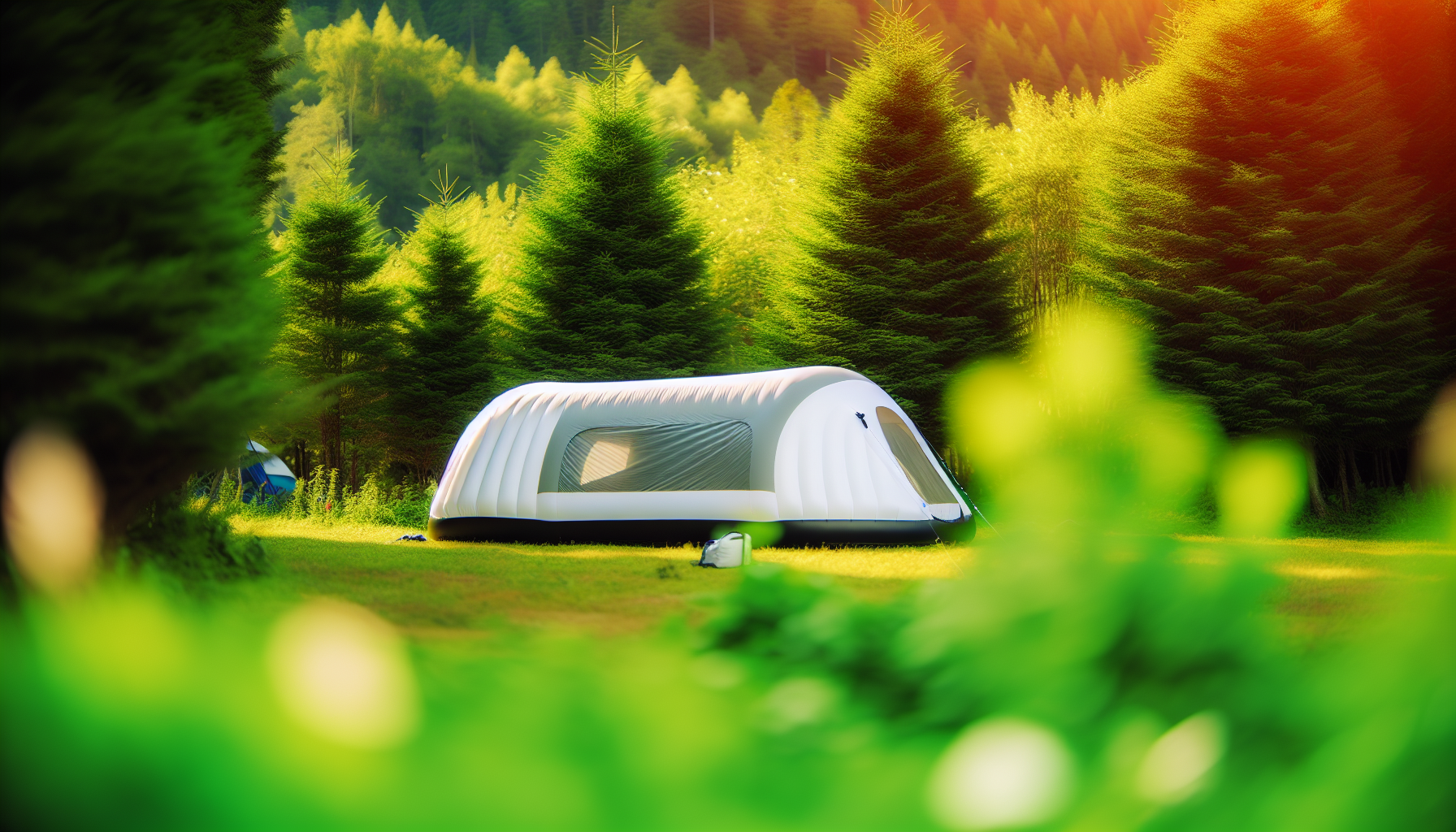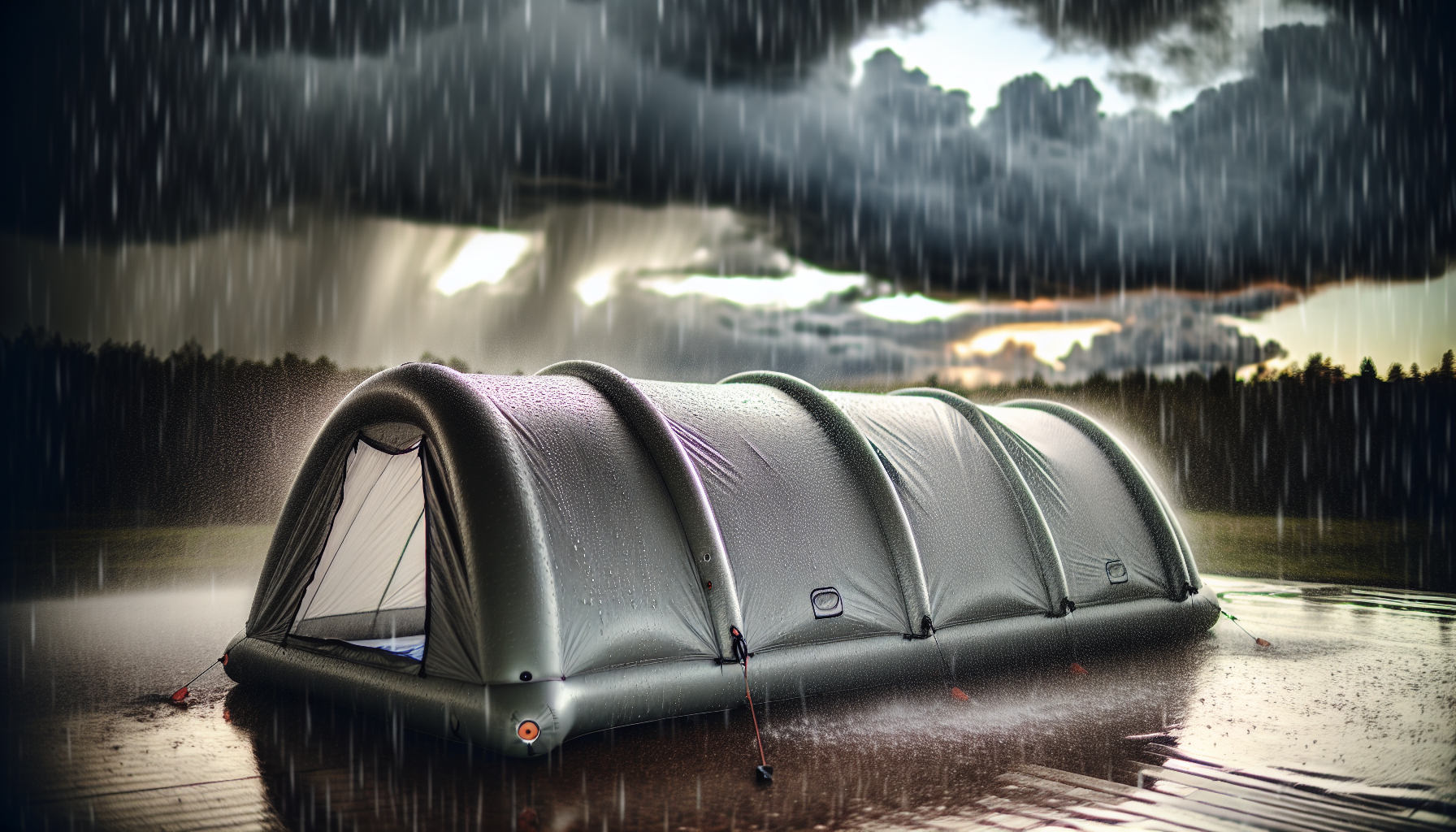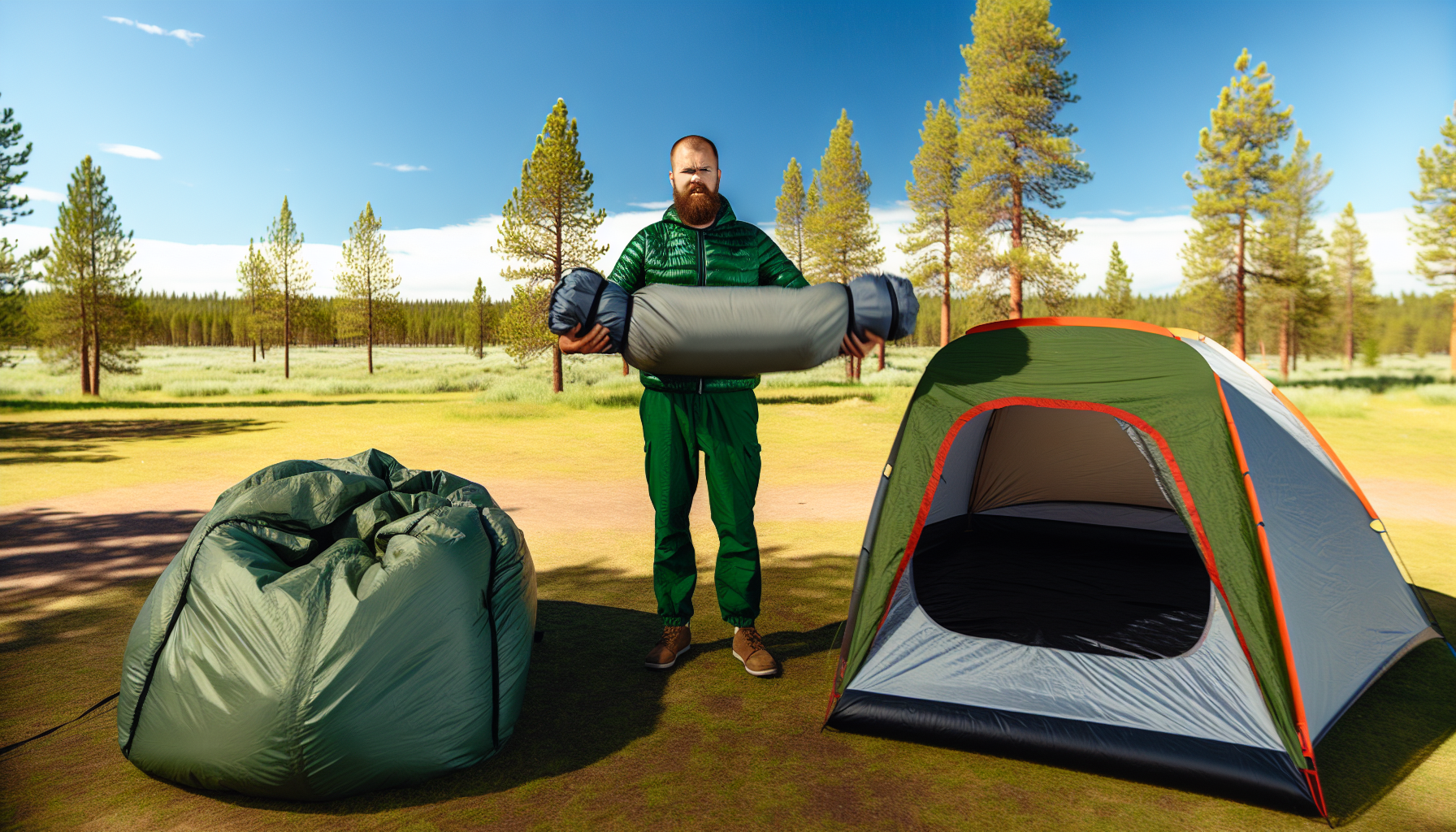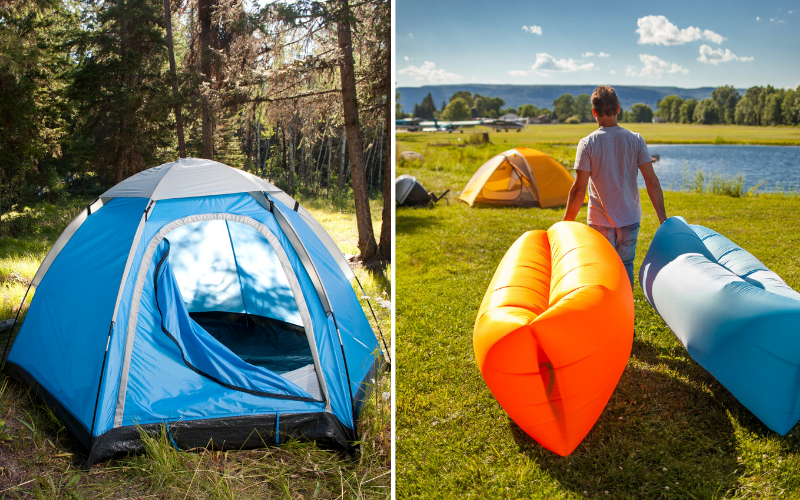Is it worth getting an inflatable tent? For many campers weighing ease of setup against bulkiness, inflatable tents have been a game-changer. This guide cuts through the fluff to uncover the true value of these modern staples in the camping world, helping you discern if they meet your outdoor needs and are worth the investment.
Key Takeaways
- Inflatable tents or air tents are super easy to set up, replacing traditional poles with air beams and potentially shaving off a significant chunk of your campsite setup time.
- Air tents are durable and weather-resistant, thanks to materials like thermoplastic polyurethane and air beams that flex in the wind - a plus for campers who hate fixing snapped pole tents.
- Although heavier and pricier, inflatable tents offer superior comfort with more space and height, multiple rooms, and can be a good investment if you think about their resilience and higher resale value.
Defining the Inflatable Tent Experience

Inflatable tents, or air tents, have gained popularity in recent years due to their innovative design and functionality. Rather than traditional poles, these air beam tents utilize inflatable beams for structural support, providing a unique camping experience. Some may even incorporate a few short solid poles for added stability.
The advantages of inflatable tents are manifold. They offer:
- Incredible stability, able to withstand heavy rain and wind without toppling over
- Easy setup, saving you precious time on the campsite
- Elimination of broken poles, a common issue with traditional tents
These features make an inflatable tent with an inner tent a standout choice for many campers seeking a camping tent, and such tents are becoming increasingly popular.
The Ease of Setup: A Closer Look

One of the main advantages of inflatable tents is their ease of setup. Say goodbye to the days of struggling with connecting poles and threading them through the tent fabric.
With an inflatable tent, setup becomes a breeze (quite literally), and you won’t even need to worry about guy ropes in such a tent.
Time Savings on the Campsite
Convenience is a key design feature of air tents, enabling a fast pitch within minutes. This saves valuable time, allowing for more exploration or relaxation. By contrast, erecting a traditional pole tent can consume 10 to 20 minutes.
Of course, factors like weather conditions and your familiarity with the tent can influence the setup time, but on average, you’ll find that air tents are a significant time-saver.
Simplifying the Process for Solo Campers
The simplicity of pitching an inflatable tent is a significant advantage for solo adventurers. Traditional tents can be a challenge to set up alone, but inflatable tents solve this problem, making them a prime choice for solo trips. With a flat surface and a few minutes, your shelter is ready.
In fact, most solo campers can set up an inflatable tent in just 10 to 15 minutes.
Durability in Diverse Conditions

Inflatable tents are not just about convenience; they also offer impressive durability. Made of sturdy materials like thermoplastic polyurethane, these tents can handle a lot of use and are built to last. This makes them an excellent choice for frequent campers or those who prefer to venture into more challenging terrains.
But what about weather resistance? Well, rest assured that inflatable tents can stand their ground in diverse weather conditions, including strong winds and heavy rain. The secret lies in the design of the air beams, which function as an air beam system. These beams can bend under wind pressure and then bounce back to their original shape, maintaining the stability of the tent. This resilience makes them superior to traditional pole tents, which are more likely to snap under extreme conditions.
Repair and Maintenance on the Go
Inflatable tents are not immune to damage, but they are easier to repair compared to their pole counterparts. Common issues such as punctures from sharp objects or valve malfunctions can be easily addressed using puncture repair kits. These kits typically include patches, adhesive, and sometimes a tool for applying the adhesive.
With regular cleaning, proper storage in a carry bag, and attentive handling, you can keep your inflatable tent in good shape for many camping trips to come.
Space and Comfort: The Luxury of Multiple Rooms

Space and comfort are important factors when choosing a tent, and this is another area where inflatable tents shine. These tents offer spacious interiors with ample headroom, making them a comfortable choice for longer camping trips. But the luxury doesn’t stop there. Many inflatable tents come with multiple rooms, providing a high-end camping experience reminiscent of a mobile home.
As for the number of rooms, some models astonishingly offer up to five rooms, providing separate sleeping and living areas for relaxation, dining, and gear storage. With the peak height in bedrooms often around 210cm (82.7in), most campers can comfortably stand upright, a spaciousness that traditional pole tents struggle to match.
Comparing Weight and Portability

Despite the high scores inflatable tents receive for convenience, durability, and comfort, they carry a potential downside: their weight. Air tents are typically heavier and bulkier than traditional pole tents. Yet, many campers find the benefits they bring outweigh this extra weight, making it a reasonable trade-off.
For instance, the Osiris Air 500 weighs 15.3kg/33.7lb and packs down to 73 x 34 x 34cm/28.7 x 13 x 13in, while the Aether 450 weighs 21.1kg/46.5lb with a pack size of 73 x 42 x 42cm/29 x 16.5 x 16.5in. Although these weights and packed sizes are larger than those of pole tents, they are still manageable for most campers, especially when you consider the convenience and comfort they deliver.
Longevity and Investment
Investing in an inflatable tent can be a smart move, especially if you’re a frequent camper. These tents are built to last, with a lifespan that can range from a few years to over a decade, depending on how well you take care of them.
High-quality materials and solid construction, combined with proper use and maintenance, can help extend the life of your inflatable tent to as long as 20 to 30 years.
Resale Value in the Market
Another factor to consider is the potential resale value of your inflatable tent. Compared to traditional pole tents, air tents generally have a higher resale value, making them a smart investment for regular campers. Of course, the brand and condition of the tent will impact its resale value, but well-maintained inflatable tents from reputable brands can fetch a decent price in the second-hand market.
Adapting to Different Camping Styles
Inflatable tents are renowned for their versatility. They cater to a range of campers, from solo adventurers to summer vacationing families, and even groups of friends on backpacking trips. Suitable for all seasons and varying trip lengths, there’s an inflatable tent to fit every camping style.
Moreover, the market offers a range of inflatable tents designed specifically for different camping styles. For instance, inflatable tunnel tents and models like the Kampa Hayling 4 Classic Air Pro are perfect for family camping trips. So, when choosing an inflatable tent, consider your camping style, the season, and your personal preferences to ensure you get the most out of your tent.
Innovations and Trends in Tent Technology
Camping gear is an ever-evolving industry, and inflatable tents are part of this progression. The recent advancements in inflatable tent technology include:
- Enhanced materials
- Design improvements
- Automated inflation systems
- Environmentally friendly options
These advancements aim to boost performance, durability, and convenience for car camping enthusiasts during their camping trip.
For instance, high-pressure inflatable tents are gaining popularity for their enhanced stability and resistance to wind. Modular tent styles, which allow you to customize your setup, are also making waves in the market. With such ongoing innovations, the future of camping looks bright and exciting, promising new levels of comfort and convenience for outdoor enthusiasts.
Making the Choice: Is an Air Tent Right for You?
Ultimately, the decision to choose an inflatable tent comes down to your personal preferences, camping style, and budget. If you value ease of setup, durability, and comfort, an inflatable tent could be a great choice for you. However, keep in mind that these tents tend to be heavier and more expensive than traditional pole tents. So, consider these factors carefully before making your decision.
If you’re a frequent camper, the investment in an inflatable tent could pay off in the long run. These tents are built to last and offer a level of comfort and convenience that’s hard to match. Plus, with the potential for a higher resale value, an inflatable tent can be a smart choice for those who love to camp regularly.
Summary
Inflatable tents have made a significant impact on the camping scene, offering a unique blend of convenience, durability, and comfort. With their easy setup, resilient design, spacious interiors, and adaptability to different camping styles, these tents are a compelling choice for many campers. While they are heavier and costlier than traditional pole tents, the benefits they provide could well justify the extra weight and cost for many.
In the end, choosing the right tent is a personal decision based on your camping style, preferences, and budget. But with the ongoing innovations and advancements in tent technology, it’s clear that inflatable tents are here to stay. So, next time you’re planning a camping trip, why not consider going with the flow and trying out an inflatable tent?
Frequently Asked Questions
What are the disadvantages of inflatable tents?
Inflatable tents can be more expensive than traditional tents and may be susceptible to punctures or leaks. It's important to consider these drawbacks before making a purchase.
What are the benefits of an inflatable tent?
Inflatable tents offer quick setup, enhanced stability, and spacious interiors, making them a popular choice for outdoor enthusiasts. Plus, their versatility adds to their appeal.
Why are inflatable tents so expensive?
Inflatable tents are more expensive because they are made from a stronger material, similar to a higher-quality airbed being pricier than a budget one. So, the durability and reliability of the material justify the higher cost.
Are inflatable tents good for winter?
Yes, inflatable tents are good for winter because they provide better insulation with air inside the structure, keeping you warm and comfortable.
What makes an inflatable tent different from a traditional pole tent?
An inflatable tent is different from a traditional pole tent because it uses air-inflated beams for support, which provides easy setup, durability, and the ability to withstand diverse weather conditions.
You Might Also Like...










